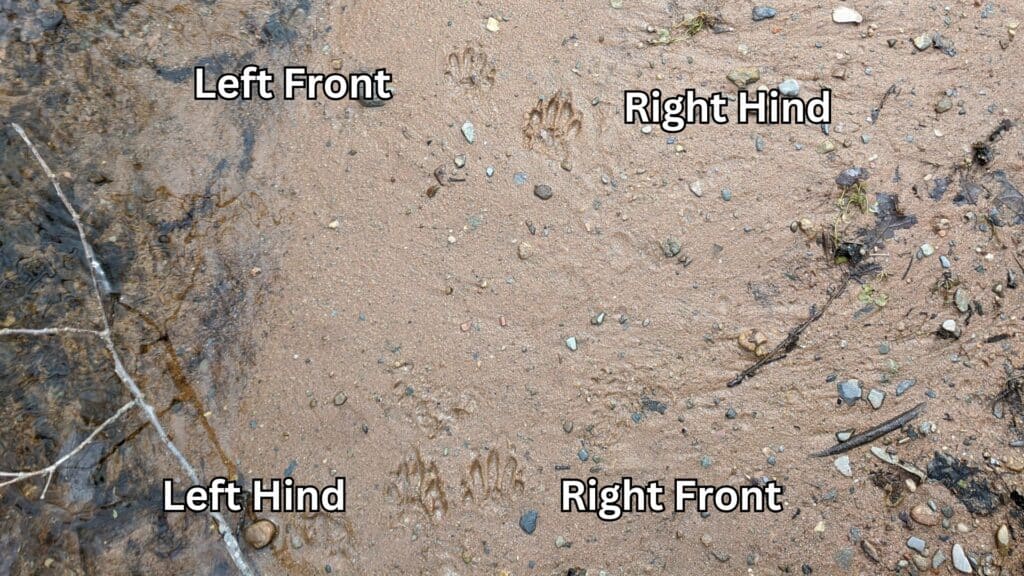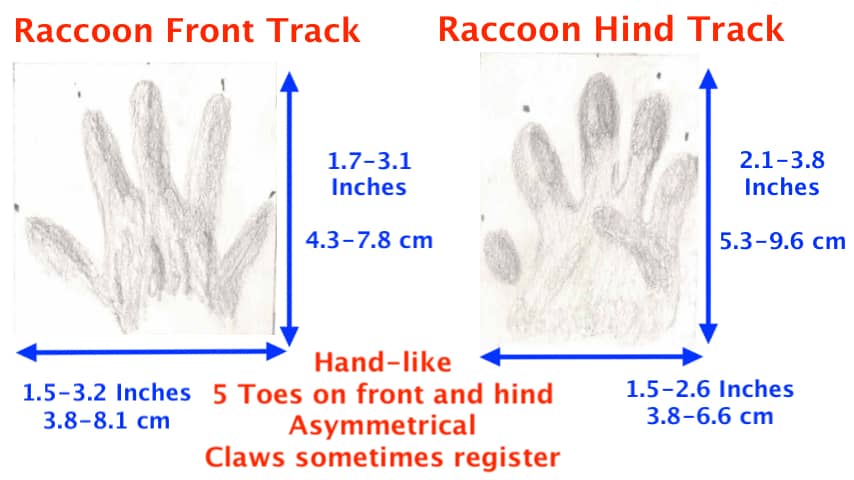Raccoon tracks are extremely common, but telling them apart from other animals can be surprisingly tricky depending on the conditions (sand vs mud vs snow).
Part of the challenge is their front and hind tracks look quite different, which means even telling their own front feet from hind feet isn’t always easy.
To illustrate this difference, take a look at this example showing both tracks together:

Generally, you’re looking for 5 fingerlike toes on both front (F) and hind (H) tracks. But count them and you’ll notice this trait is much more clear on the front.
The Front track (F) often seems a bit wider and more ‘hand-like’ than the longer Hind track (H).
So how can you know for sure if you’ve found raccoon tracks? Confident raccoon ID comes from mastering the front vs. hind differences AND comparing tracks to look-alikes like cats, skunks & opossums. Let’s dive in!
Key Differences Between Front & Hind Raccoon Tracks
Key Raccoon Tracking Tip: Whenever possible, always try to find more than 1 or 2 tracks. Raccoons have a very distinct walking gait that alternates front and hind tracks side by side as shown in the following example:

This means very often when you see a raccoon trail, you will actually see two tracks side by side that includes a front and hind. This is a great opportunity to look closer and notice more subtle differences.
One of the most notable differences between front and hind raccoon tracks is the relative size of their inner toe.

In tracking terminology the inner toe is sometimes referred to as toe #1 (in human terms, it’s the thumb) and in raccoons it’s much shorter on the hind foot compared to the front.
Because raccoons have such a short inner toe on the hind foot, it’s quite common for beginners to misread the track as having 4 toes when there are actually 5.
This short toe combined with less overall splaying of the foot is what makes the hind track appear much less hand-like than the front.

You might also notice the hind track appears a little bit larger than the front (although this is easiest to see in ideal substrates like snow or mud).
The size difference is subtle, but definitely noticeable when measured with a ruler. Overall raccoon tracks measure 1.5-3.2 inches across and 1.7-3.8 inches in length.

So next let’s explore some of the most common misidentifications with raccoon tracks like cat, skunk & opossum tracks.
Raccoon vs Cat Tracks

Generally, the easiest way to tell raccoon tracks from cat tracks is to count the toes. Raccoons have 5 toes while cats only have 4.
This is true for all bobcats, house cats, mountain lions, tigers, etc.
For this reason whenever you’re dealing with clear tracks that show all the toes, it’s basically impossible to confuse raccoons and cats.
However, it is possible to confuse raccoons with cats in situations when the tracks are only partially registering.
This mistake is most likely to be made when you find a raccoon track that doesn’t register toe #1 (as discussed in the above section).
When you’re dealing with partial tracks, the best way to identify raccoon vs cat tracks is by looking at the negative space between the toes and the palm.
Raccoon tracks have no negative space so the toes connect directly into the palm like fingers, while cat toes will have an obvious space between.
Raccoons are also much more likely to register claws, while cats typically do not register claws.
In many cases, size is another good way to tell them apart. House cats are also usually much too small to confuse with raccoons, and anything larger than a bobcat is too big.
Raccoon vs Skunk Tracks

In the case of raccoon vs skunk tracks, both animals have 5 toes with claws that could potentially cause confusion.
However, raccoon tracks are noticeably larger than skunk tracks which usually makes them fairly easy to tell them apart.
I always recommend trackers buy a field guide with life-size tracks, like Mark Elbroch’s Mammal Tracks & Sign.
Practice sketching life-size skunk and raccoon tracks to get a feel for how their size compares and this difference will become very clear.
Similar to the cat example from above, another big difference between skunks & raccoon tracks is the long fingerlike toes of a raccoon that connect directly into the palm without leaving any negative space.
Skunk toes (except the front thumb) will be disconnected from the palm, with an obvious negative space.
Skunk tracks also have the middle 3 toes clumped together in a set and an extra heel pad at the back of the front foot, while raccoon toes are more evenly spaced.
Look for these features and telling raccoon from skunk tracks is super easy!
Raccoon vs Opossum Tracks

When it comes to raccoon vs opossum tracks, again we’re dealing with two animals that both have 5 toes and claws that sometimes register in the track.
To make it more confusing, opossum tracks have the similar feature of long toes that connect directly into the palm without any negative space (just like raccoons).
However, the big difference here is opossum tracks have very sharply angled toes that splay out much more prominently and asymmetrically than raccoons.
Opossum tracks are sometimes described as having a more starlike appearance with toes emanating out from the center, while raccoon tracks have toes that mostly point forward in comparison.
Another big difference is opossums frequently move in a partial direct register which means their hind foot lands on top of (or very close to) the front foot.
The result is opossum tracks are typically overall much more confusing and distorted than raccoon tracks, making it hard to sort out how many toes and feet you’re actually seeing.
One thing a tracking instructor of mine said that helped me a lot with opossum track identification was to look for that big parallel thumb that sticks out to the side on the hind foot. This is often one of the best clues to look for.
In contrast, raccoons almost never have tracks that overlap so it’s usually fairly easy to get a clear read as long as the substrate is semi-decent.
Practice Exercises For Raccoon Track Identification
- Get outside and check around the muddy or sandy edges of water for raccoon tracks.
- Always remember to count the toes and check for negative space.
- Look for that hand-like shape on the front foot.
- Find a trail and practice labeling the front and hind tracks of raccoons.
- Practice sketching life-size tracks with measuring tools.
- Study the tracks AND the overall trail. Look for that left hind landing next to the right front.
- Keep learning more about raccoon behavior including what raccoons eat.
- Go learn some more tracks to sharpen your seeing skills!
With practice, raccoon tracks will become one of the most common and easily identified tracks you find along streams & other bodies of water. Happy tracking!
Thanks,Brian. your tutorial allowed me to make positive ID on some tracks in snow that I found curious.I had shown them to an avid outdoorsman who couldn’t ID them definitively and,in fact,figured them for squirrel(which,he said.might be larger in the snow. I found them near our pond accompanied by a women’s set of prints and a large dog.neighbors often walk out trails and pond etc.) Curiously the animal seemed to be hopping. but it turns out each set had 2 parallel prints with one of each being slightly smaller! they looked like little hand prints with the fingers registering right onto the pads(i.e. no gaps).5 toes. RACCOON! thanks
That’s awesome Brad!
Another clue for squirrels is to count both the front and hind toes. All rodents have 4 toes on their front and 5 on their hind.
With the way you describe that hopping gait near a pond, I might also look at something in the weasel family like a mink or an otter. They also have 5 toes.